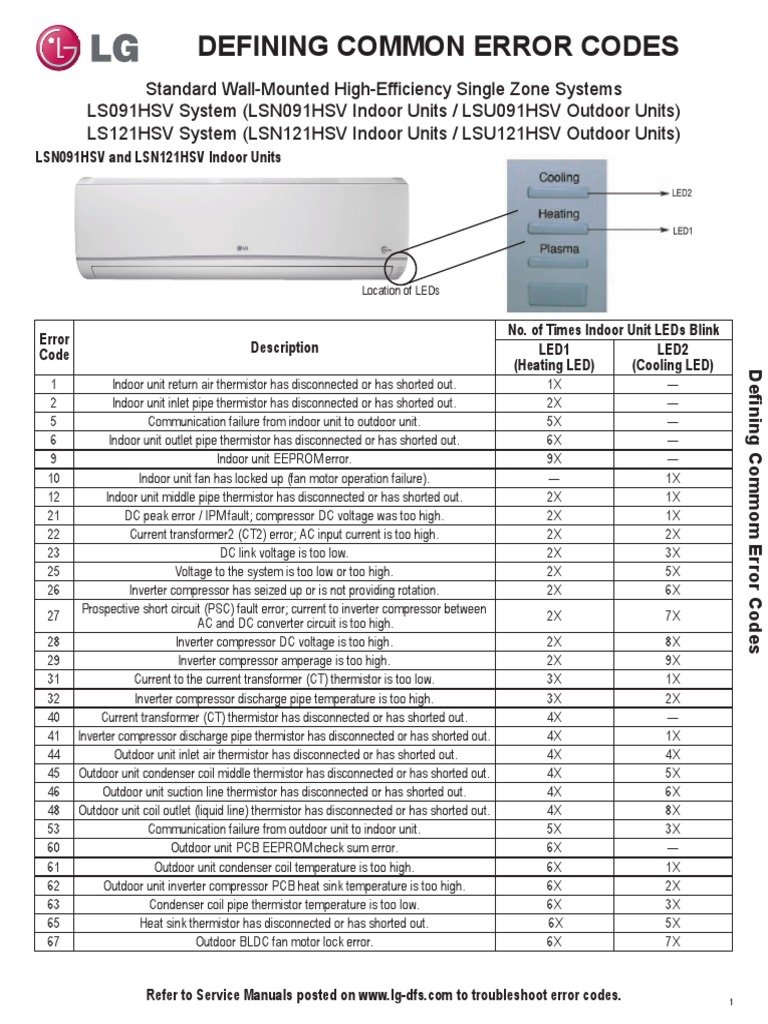
The F2 error code is your air conditioner’s way of waving a red flag. Think of it as a warning light in your car that says, “Hey, something isn’t quite right!” While it may seem daunting at first glance, understanding what this code signifies can save you a lot of hassle—and potentially prevent bigger issues down the line. In essence, recognizing when to call a technician and when you might handle things yourself can make a world of difference. Let’s unravel this, shall we?
What Does the F2 Error Code Mean?
When your LG air conditioner flashes an F2 error code, it’s essentially saying that there’s a problem with the indoor fan motor. This particular issue can stem from various causes, such as a faulty motor, a problem with the control board, or even something as simple as a loose connection. Picture it like this: if your air conditioner were an orchestra, the fan motor would be the conductor. Without it functioning correctly, the whole system can fall out of sync.
Faulty fan motors can result in inadequate airflow, meaning your unit struggles to maintain the desired temperature. Sometimes, the system might even shut down altogether to prevent further damage. You might wonder why a simple fan motor could cause such a ruckus. Well, the fan motor is responsible for the continuous movement of air across the evaporator coils, ensuring your room gets the cool air it’s yearning for. Without this, your AC can’t do its job effectively.
Here’s the deal: while some might attempt a DIY fix, it’s often a job best left to a professional, especially if you’re not familiar with the inner workings of air conditioners. Not only do they have the right tools, but they also possess the expertise to diagnose and resolve the issue swiftly. Attempting a fix without proper knowledge could lead to further damage, turning a minor inconvenience into a significant headache—and a more expensive one at that.
When To Attempt a DIY Fix
Before you pick up the phone to call a technician, there are a few things you can try to fix the F2 error code on your own. First, make sure to power off the air conditioner and unplug it to ensure safety. Just like rebooting your computer can solve many tech issues, sometimes giving your air conditioner a few minutes of rest can reset minor glitches.
Next, inspect the unit for any visible obstructions that might hinder the fan’s performance. Dust and dirt can sometimes accumulate, affecting airflow. Cleaning these areas with a soft brush or a vacuum cleaner could be just the remedy your air conditioner needs. Think of it as unclogging a pipe—once the blockage is gone, the water flows freely again.
However, if you’re not comfortable doing this or if the problem persists, it’s probably time to bring in a professional. A technician will have the specialized tools and knowledge to delve deeper into the issue without risking further damage to the unit. Remember, safety first!
Recognizing the Right Time to Call a Technician
While minor issues can be managed with a bit of elbow grease, there are scenarios when calling a technician becomes crucial. If you’ve tried the basic steps mentioned earlier and the error code remains, it’s a sign that the problem might be more complex. A persistent F2 error could indicate a deeper issue, such as a malfunctioning circuit board or wiring problems, which require expert intervention.
Additionally, if you notice unusual noises, like grinding or squealing, it could mean the fan motor is under severe strain. Just as you wouldn’t ignore strange sounds coming from your car’s engine, an air conditioner making such noises warrants immediate attention. Ignoring these signs can lead to more costly repairs or even necessitate a replacement down the road.
Moreover, consistent error codes can also result in your energy bill climbing higher than usual. A malfunctioning air conditioner often works harder, consuming more electricity to achieve the desired temperature. In such cases, a technician can not only fix the issue but also ensure your unit operates more efficiently, potentially saving you money in the long run.
Preventative Tips to Avoid Future Issues
Prevention is better than cure, and this saying holds particularly true for maintaining your air conditioner. Regular maintenance and a few preventative measures can help you dodge pesky error codes like F2. Start by scheduling annual check-ups with an HVAC professional. These routine inspections can catch potential problems early, keeping your air conditioner in top shape.
Cleaning or replacing air filters regularly is another simple yet effective measure. Dirty filters can obstruct airflow, leading to various mechanical issues, including those impacting the fan motor. It’s much like breathing through a face mask—if clogged, it becomes harder to breathe comfortably. Ensuring your filters are clean allows your air conditioner to “breathe” easily, enhancing its efficiency.
Lastly, keep an ear to the ground—or rather, to the air conditioner. Pay attention to any unusual changes in noise or performance. Early detection of abnormalities can prevent small issues from evolving into major problems. By staying vigilant and proactive, you can ensure your LG air conditioner runs smoothly, providing the cool comfort your home needs.
In conclusion, while encountering an F2 error code might seem intimidating at first, understanding what it entails and knowing how to address it can alleviate much of the stress. Whether opting for a DIY approach or calling in a professional, the key is to act promptly to avoid further complications. By taking preventative steps, you ensure your air conditioner operates efficiently, keeping your home a cool haven regardless of the season.